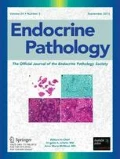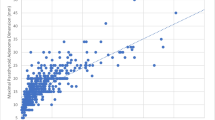Abstract
Oxyphil cell parathyroid adenomas (OPA) are considered to be an uncommon cause of primary hyperparathyroidism (PHPT), and were historically thought to be clinically silent. It has been our clinical impression that these adenomas present more often than previously thought and may manifest a more severe form of primary hyperparathyroidism than classical adenoma. The aim of this study was to describe the incidence and clinical presentation of OPA. An observational case-control study was undertaken. The study group comprised patients undergoing parathyroidectomy for PHPT where the final pathology confirmed OPA. The controls were made up of an age- and sex-matched group of patients having parathyroidectomy in the same time period where the final pathology confirmed a classical or non-oxyphil adenoma. OPA were defined as parathyroid tumours containing >75 % oxyphilic cells. The OPA cases were obtained by reviewing all histopathology slides over an 11-year period (2002–12) where the reports contained the words ‘oxyphil’ or ‘oxyphilic’ parathyroid adenomas. These were then reviewed by two independent pathologists to confirm a diagnosis of OPA. The primary outcome measures were preoperative serum calcium and parathyroid hormone (PTH) levels. Secondary outcome measures were symptoms at presentation, accuracy of preoperative localization studies, parathyroid gland weight following surgery, and type of surgery undertaken. In the period 2002–2012, 2739 patients underwent surgery for PHPT. Following pathological review, 91 cases were confirmed as being OPA and formed the study group. A control group (n = 91) from the same period was selected following matching on the basis of age at presentation and sex. OPA were associated with higher preoperative serum calcium (10.84 versus 10.48 mg/dL, p < 0.001) and parathyroid hormone (139 versus 64 ng/L, p < 0.001). At presentation, a lower proportion of OPA cases had asymptomatic disease (15 versus 29 %, p = 0.03). There was a trend toward a higher rate of renal calculi at presentation in the OPA group (9 versus 3 %, p = 0.07). Preoperative ultrasound was less accurate in localization of OPA when compared with classical adenoma. The rate of minimally invasive surgery was 67 % for OPA and 78 % for the control group (p = 0.06). All patients were cured of hypercalcaemia at 6-month follow up. There was no significant difference in the weight of removed parathyroid tissue between the groups (868 mg for OPA versus 789 mg for the control group, p = 0.6). OPA are frequently symptomatic and are associated with higher preoperative serum calcium and parathyroid hormone levels than classical types of parathyroid adenomas. OPA are less likely to be localised on preoperative ultrasound examination.

Similar content being viewed by others
References
Felger EA, Kandil E. (2010) Primary hyperparathyroidism. Otolaryngol Clin N Am 43: 417–432.
Gurrado A, Piccinni G, Lissidini G, et al. (2012) Hypercalcaemic crisis due to primary hyperparathyroidism - a systematic literature review and case report. Endokrynol Pol 63 (6): 494–502.
Carlson D. (2010) Parathyroid pathology. Arch Pathol Lab Med 134: 1639 – 1644.
Bleier BS, LiVolsi VA, Chalian AA, Gimotty PA, Botbyl JD, Weber RS (2006) Technetium Tc99m sestamibi sensitivity in oxyphil cell-dominant parathyroid adenomas. Arch Otolaryngol Head Neck Surg 132: 779–82.
DeLellis RA. (2011) Parathyroid tumours and related disorders. Modern Pathology 24: 578–593.
Warren S, Morgan Jr E. (1935) The Parathyroids: II. A Histologic study of parathyroid adenoma. Arch Pathol 20: 823 – 826.
LiVolsi VA, Parathyroids: morphology and pathology. (2001) In: Bilezikian JP (ed) The parathyroids: basic and clinical concepts. 2nd ed. San Diego: Academic Press; 1–16
Giorgadze T, Stratton B, Balock ZW, et al. (2004) Oncocytic parathyroid adenoma: problem in cytological diagnosis. Diagnostic Cytopathology 31(4): 276 – 280.
Christie AC. (1967) The parathyroid oxyphil cells. J Clin Pathol 20(4): 591–602
Benard F, Lefebvre B, Beuvon F, Langlois MF, Bisson G (1995) Rapid washout of technetium-99m-MIBI from a large parathyroid adenoma. J Nucl Med 36: 241 – 243.
Carpentier A, Jeannotte S, Verreault J, Lefebvre B, Bisson G, Mongeau C, Maheux P (1998) Pre-operative localisation of parathyroid lesions in hyperparathyroidism: relationship between technetium-99m-MIBI uptake and oxyphil cell content. J Nucl Med 39 (8): 1441–1444.
Thompson GB, Mullan BP, Grant CS et al. (1994) Parathyroid imaging with technetium-99m-sestamibi: an initial institutional experience. Surgery 116: 966-p973
Wei JP, Burke GJ, Mansberger AR Jr (1992) Prospective evaluation of the efficacy of technetium 99m sestamibi and iodine 123 radionuclide imaging of abnormal parathyroid glands. Surgery 112: 1111 – 1117.
Castleman B, Roth SI (1978) Tumours of the parathyroid glands. In: Atlas of Tumor Pathology, series 2, fascicle 14 Washington DC, Armed Forces Institute of Pathology
DeLellis RA, Lloyd RV, Heitz PU, et al. (2004) World Health organization classification of tumours Pathology and Genetics: Tumours of Endocrine Organs IARC Press Lyon.
Fleischer J, Becker C, Hamele-Bena D, et al. (2004) Oxyphil parathyroid adenoma: A malignant presentation of a benign disease. J Clin Endocrinol Metab 89(12): 5948 – 5951.
Erickson LA, Jin L, Papotti M, et al. (2002) Oxyphil parathyroid carcinomas: a clinico pathologic and immunohistochemical study of 10 cases. Am J Surg Pathol 26: 344 – 349.
Sandler R, Jourdain LM, Damjanov I. (1981) Functioning oxyphil parathyroid adenoma. Annals of Clinical and Laboratory Science 11(2): 180 – 183.
Conflict of interest
The author(s) declare that they have no competing interests.
Author information
Authors and Affiliations
Corresponding author
Rights and permissions
About this article
Cite this article
Howson, P., Kruijff, S., Aniss, A. et al. Oxyphil Cell Parathyroid Adenomas Causing Primary Hyperparathyroidism: a Clinico-Pathological Correlation. Endocr Pathol 26, 250–254 (2015). https://doi.org/10.1007/s12022-015-9378-3
Published:
Issue Date:
DOI: https://doi.org/10.1007/s12022-015-9378-3




